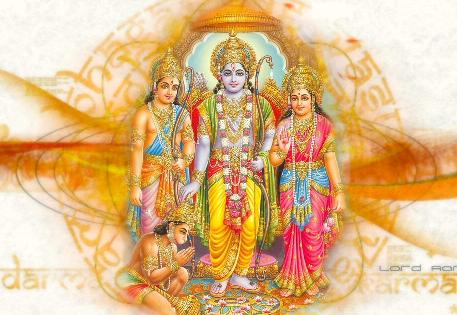The Ramayana in contemporary Bharat

The significance of the Ramayana, whether by Valmiki, Kamban, Tulsidas, Ezuthatchan is that of a devotional prayer. Lord Rama is portrayed as the ideal hero, the ideal individual, maryadarama, and his reign in Ayodhya as the fulfillment of the Vedic ideal of a just polity, a dharmic state, with justice and equality for all. The Vedic seers saw this long before any modern ideals of a just society were formulated. It is no accident that Gandhiji spoke frequently of the Ramarajya. And Indians who are not familiar with that most ancient of Bharat’s thought on the subject may fondly imagine that justice and equality are western importations, that social philosophy somehow originated only in the West. The dharma of Ayodhya is a continuation of an ancient social philosophy.
While one could analyse this devotional epic from a modern standpoint and take it apart from various angles (and there are novelists and shortstory writers, critics and secularists and leftists etc who have done so (India is a free country!) the ideal remains intact in the Hindu ethos. Why is this so ? Afterall, there are violent episodes of war as Rama and his beleagured army of vanaras and forest dwellers fight the agents of the all powerful Ravana. It cannot simply be because of the age old human longing for the victory of good (represented by Rama) over evil (represented by Ravana).
It is because both the everyday Hindu and the intellectualized Hindu and yes the deracinated Hindu and the false secularists and the modernists all recognize that Rama is a dharmic hero. The secularists and modernists and the leftists may outwardly criticize Rama as a feudal prince at best and at worst . . . . . but they cannot shake off the feeling that he is somehow ingrained in their consciousness. He speaks to their deepest longing for a just society. Deep inside them, they know that. Deep inside them even when corrupted by their contemporary modernisms they echo Hanumanji’s prayer for the return of Rama.
In today’s India of super corrupt governance, the dharmic society and state are no longer the bugaboo they once tried to make it out to be. The Vedic ideal expressed so poignantly in the Gayatri, described as the mother of the Veda, seems to have become embodied in the Ayodhya of Bharat’s dreams. It is not an accident that Rama is from the solar dynasty, since the Gayatri is the personification of the radiance and plenitude of the sun.
The worship of the terrestrial, the atmospheric and celestial deities in the Rig Veda is possible because there is no one dogmatic God who rules over the universe, as in the monotheistic faiths with their violence and conquest over the peoples of the earth.
The three worlds are changing and dynamic and open up various possibilities. Hence the Rig Veda is a celebration of life and human society mirrors this celebration. Ayodhya is a world of plenty, of justice, peace and prosperity to all. Sarve bhavantu sukhinah (May all beings be happy !) includes the earth, and the entire universe. Includes all people in society.
The Rama of Ayodhya evokes that dharmic state of well being for all creatures and the environment. Hence, in the Malayalam version by Ezuthatchan, there is an ecstatic invocation of the radiant Rama. Almost a dozen lines call upon Rama, as the ruler not just of Ayodhya, but of the entire world !
This may not be a bad prayer afterall !And it might well be that Bharat has lasted for several millennia and will last for several more because the notion of Punya Bhumi, sacred earth, extends to the entire planet and the invocation to the Gayatri sends out a message to the entire planet for all time:
Gayatri yai dirghai namaha !
Long live Gayatri and one can add: Long live Ayodhya ! Long live the just society, the dharmic society that all Hindus can/should strive for. The Ramayana is for all time.
(The writer is a Political Philosopher who taught at a Canadian university).
Welcome to Haindava Keralam! Register for Free or Login as a privileged HK member to enjoy auto-approval of your comments and to receive periodic updates.
Latest Articles from Dharma Smriti
- In memory of Dr N Gopalakrishnan
- Treading the Middle-Path on Temple Management
- ആദി ശങ്കര ജയന്തി – പ്രഭാഷണം
- അമേരിക്കന് പ്രൊഫസര് ജോണ് ഗ്രൈംസിന് ഭഗവാന് ഗണേശന് കൊടുത്ത ദിവ്യാനുഭവം
- Forgotten Temples Of Malappuram – Part I (Nalambalam of Ramapuram)
- Holy Karkidakam – Ramayana to Echo from Haindava Homes
- Poonthanam’s complete works translated into English
- Pamba Aarati – Dispell the Engulfing Darkness
- Milords! What the judiciary must know before any final verdict on Sabarimala
- Swami Chidanandapuri on Sabarimala


Responses